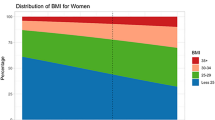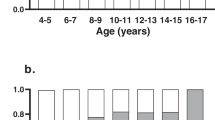Abstract
OBJECTIVE: Obesity prevention is necessary to address the steady rise in the prevalence of obesity. Although all experts agree that obesity prevention has high priority there is almost no research in this area. The effectiveness of different intervention strategies is not well documented. There is also no structured framework for obesity prevention.
DESIGN: Based on (i) our current and limited knowledge and (ii) the idea that prevention of childhood obesity is an effective treatment of adult obesity, the Kiel Obesity Prevention Study (KOPS) was started in 1996. Concept, intervention strategies and first results of KOPS are reported in this paper. KOPS is an ongoing 8 y follow-up study. We first enrolled a large scale cohort of 5 to 7-y-old children, providing sufficient baseline data. KOPS allows further analyses of the role of individual risk factors as well as of long-term effectiveness of different intervention strategies.
RESULTS: From 1996 to 1999 a representative group of 2440 5 to 7-y-old children was recruited (ie 30.2% of the total population of 5 to 7-y-old children examined by the school physicians) and a full data set was obtained from 1640 children. Of the children, 340 (20.7%) were considered as overweight and obese, 1108 children (67.6%) were normal weight, and underweight was found in 192 children (11.7%). Of the normal-weight children, 31% or 346 (21.1% of the total population) were considered to have a risk of becoming obese. Cross-sectional data provided evidence that (i) there is an inverse social gradient in childhood overweight as well as health-related behaviours and (ii) parental fatness had a strong influence on childhood overweight. We observed considerable changes in health-related behaviours within 1 y after combined ‘school-’ and ‘family-based’ interventions. Interventions aimed to improve health-related behaviours had significant effects on the age-dependent increases in median triceps skinfolds of the whole group (from 10.9 to 11.3 mm in ‘intervention schools’ vs from 10.7 to 13.0 mm in ‘control schools’, P<0.01) as well as in percentage fat mass of overweight children (increase by 3.6 vs 0.4% per year without and with intervention, respectively; P<0.05).
CONCLUSION: First results of KOPS are promising. Besides health promotion, a better school education and social support seem to be promising strategies for future interventions.
This is a preview of subscription content, access via your institution
Access options
Subscribe to this journal
Receive 12 print issues and online access
$259.00 per year
only $21.58 per issue
Buy this article
- Purchase on Springer Link
- Instant access to full article PDF
Prices may be subject to local taxes which are calculated during checkout
Similar content being viewed by others
Author information
Authors and Affiliations
Corresponding author
Rights and permissions
About this article
Cite this article
Müller, M., Asbeck, I., Mast, M. et al. Prevention of obesity—more than an intention. Concept and first results of the Kiel Obesity Prevention Study (KOPS). Int J Obes 25 (Suppl 1), S66–S74 (2001). https://doi.org/10.1038/sj.ijo.0801703
Issue Date:
DOI: https://doi.org/10.1038/sj.ijo.0801703
Keywords
This article is cited by
-
A cluster randomised controlled trial to investigate the effectiveness and cost effectiveness of the ‘Girls Active’ intervention: a study protocol
BMC Public Health (2015)
-
A primary-school-based study to reduce the prevalence of childhood obesity – the EdAl (Educació en Alimentació) study: a randomized controlled trial
Trials (2014)
-
Adiposity rebound is misclassified by BMI rebound
European Journal of Clinical Nutrition (2013)
-
A conative educational model for an intervention program in obese youth
BMC Public Health (2012)
-
The LIFE child study: a life course approach to disease and health
BMC Public Health (2012)



